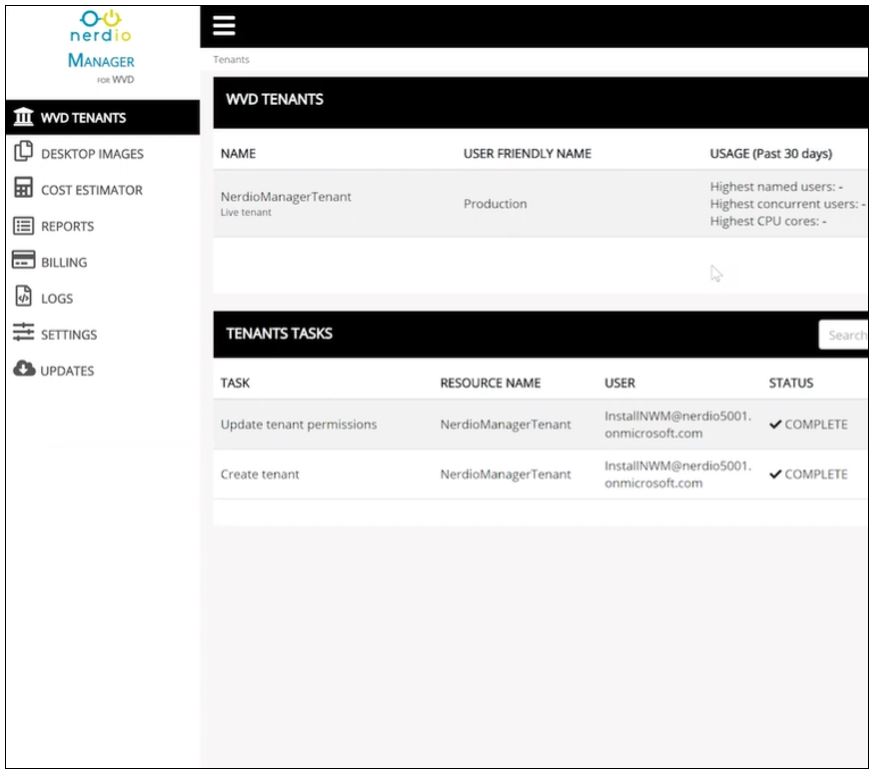Nerdio has introduced a solution designed to streamline deployment and management of Microsoft Windows Virtual Desktop (WVD) for organizations with existing Microsoft Azure footprints.
Named Nerdio Manager for WVD and currently in public preview, the system lets users insert Windows desktops within existing Azure environments rather than build such environments from scratch. That distinguishes it from the previously released Nerdio for Azure, which helps organizations implement complete Azure solutions and infrastructure.
“It’s a packaged Azure application that gets installed by the customer inside of the customer’s own Azure environment,” says Nerdio CEO Vadim Vladimirskiy. “It allows someone to take all the work they’ve done up until now, take that existing environment, and add WVD into the mix.”
The system is engineered to accommodate the needs of end users with security concerns and compliancy requirements as well, he adds. Unlike comparable solutions with multi-tenant remote administration tools, Nerdio Manager for WVD comes with a dedicated management plane for in-house use only.
“It doesn’t allow any third parties access into their environment,” Vladimirskiy says, noting that increased threat activity against MSPs has made some end users uneasy about multi-tenant management systems.
Customers subject to regulations like GDPR can also use the new system to keep their WVD deployment in compliance with data residency requirements. “The customer chooses what region to store the data in, and it’s completely under their control,” Vladimirskiy states.
For MSPs, he continues, the new product offers an easy way for clients who already use Azure to evaluate WVD as well.
“Lots of partners are getting a lot of interest, and certainly a lot of tire-kicking type of activity, from their customers who are hearing about all the buzz around WVD,” Vladimirskiy says. “This really allows them to take on a customer that has an existing Azure deployment and non-disruptively give the customer the opportunity to test WVD very quickly without much engineering expertise or investment into labor.”
Nerdio has witnessed the curiosity about WVD firsthand. The Azure implementation and administration specialist has already performed WVD rollouts for over 1,000 customers. Nerdio Manager for WVD’s feature set reflects input from some of those businesses that had existing Azure resources.
“They were already in Azure, they already had Active Directory, they already had file services, they sort of had all the building blocks ready to go,” Vladimirskiy says. “They didn’t want to kind of reinvent the wheel of what was already in place. They just wanted to add WVD on top of it into the mix.”
Those were mostly larger businesses, Vladimirskiy adds, noting that Nerdio Manager for WVD is optimized for such organizations. “It’s not really for a 10- or 100-person company, but several hundred users and up is really a great fit.”
Nerdio offers two pricing options for the system. Companies that want a dedicated virtual desktop for each of their employees can pay $4 per seat per month for the “named user” plan. Companies that want employees to share a set of WVD licenses can pay $6 per seat per month instead for the “concurrent user” plan.
“The concurrent model works for companies that have multiple shifts of employees or have a very large number of users in their environment but only a small subset of them would ever be using the system at the same time,” Vladimirskiy says.
Nerdio Manager for WVD is designed to fill what the vendor sees as a hole in the market for automated, intuitive WVD implementation and management systems.
“Right now, the WVD native product is all command line based,” Vladimirskiy says. “In order to deploy it and to manage it, you need to do PowerShell-based management, basically.”
Other solutions, such as Citrix Workspaces and VMware’s Horizon Cloud platform, also streamline Windows desktop rollouts. According to Vladimirskiy, however, those products use proprietary agents and connection brokers that can make migrating desktops difficult.
“If you want to go from VMware to [Microsoft] native or Citrix to native, you actually have to migrate out and rebuild and redo all of that initial work,” he says. Nerdio Manager for WVD, by contrast, is a standalone overlay that users can uninstall at any time.
“It has no proprietary components, so there’s really zero vendor lock-in,” Vladimirskiy says.
Nerdio Manager for WVD is an all-new solution, rather than an adaptation of Nerdio for Azure. “It’s a subset of what Nerdio for Azure does, but it goes much deeper and it has a lot more knobs you can turn,” Vladimirskiy says. He expects the system to become generally available within a few weeks.
Nerdio, which recently raised $8 million of venture capital, announced distribution deals with Ingram Micro, as well as Pax8 and D&H, last year. An estimated 60 to 70% of the sales leads the company receives at present are related to WVD.














